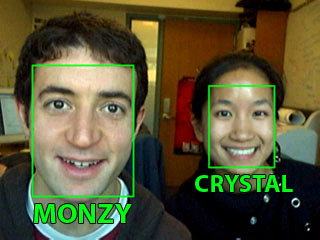| Introduction | Course Objectives | Course Staff | Links | Course Calendar | Course Assignments | ||||||||||||||||||||||||||||||||||||||||||||||||||||||||||||||||||||||||||||||||||||||||||||||||||||||||||||||
| Introduction | ||||||||||||||||||||||||||||||||||||||||||||||||||||||||||||||||||||||||||||||||||||||||||||||||||||||||||||||
Computer vision can be a powerful tool for HCI applications. Camera-based input has been used effectively on mobile devices, in tangible user interfaces, and in a variety of ubiquitous computing applications. The computer vision literature contains a wide variety of sensing and processing techniques that are applicable to HCI, but in general these techniques have not been widely adopted by HCI practitioners.
Rather than focus on the gory mathematical details of computer vision algorithms, we consider how these algorithms can be used effectively in real systems. Students will be shown how to apply existing computer vision tools, techniques, and libraries, without needing any in-depth experience in mathematics or programming. Applying computer vision to HCI has different requirements and goals than the traditional applications of computer vision: results must be available quickly, but the detail of information required is often much more limited (e.g. high-level classification of events rather than detailed 3D reconstruction of a scene). In addition, since a human is in the loop, feedback can be used to allow iteration and adaptation of software and user behavior. |
||||||||||||||||||||||||||||||||||||||||||||||||||||||||||||||||||||||||||||||||||||||||||||||||||||||||||||||
| Back to top | ||||||||||||||||||||||||||||||||||||||||||||||||||||||||||||||||||||||||||||||||||||||||||||||||||||||||||||||
| Course Objectives | ||||||||||||||||||||||||||||||||||||||||||||||||||||||||||||||||||||||||||||||||||||||||||||||||||||||||||||||
The primary objectives of CS377S are:
|
||||||||||||||||||||||||||||||||||||||||||||||||||||||||||||||||||||||||||||||||||||||||||||||||||||||||||||||
| Back to top | ||||||||||||||||||||||||||||||||||||||||||||||||||||||||||||||||||||||||||||||||||||||||||||||||||||||||||||||
| Course Staff | ||||||||||||||||||||||||||||||||||||||||||||||||||||||||||||||||||||||||||||||||||||||||||||||||||||||||||||||
|
||||||||||||||||||||||||||||||||||||||||||||||||||||||||||||||||||||||||||||||||||||||||||||||||||||||||||||||
| Back to top | ||||||||||||||||||||||||||||||||||||||||||||||||||||||||||||||||||||||||||||||||||||||||||||||||||||||||||||||
| Links | ||||||||||||||||||||||||||||||||||||||||||||||||||||||||||||||||||||||||||||||||||||||||||||||||||||||||||||||
Course Website: http://cs377s.stanford.edu/ Course Newsgroup: su.class.cs377s Please use the newsgroup for discussion and general questions about assignments. Course Staff Mailing List: cs377s-win0708-staff at lists dot stanford dot edu |
||||||||||||||||||||||||||||||||||||||||||||||||||||||||||||||||||||||||||||||||||||||||||||||||||||||||||||||
| Back to top | ||||||||||||||||||||||||||||||||||||||||||||||||||||||||||||||||||||||||||||||||||||||||||||||||||||||||||||||
| Course Calendar | ||||||||||||||||||||||||||||||||||||||||||||||||||||||||||||||||||||||||||||||||||||||||||||||||||||||||||||||
|
Lectures are held on Tuesdays and Thursdays from 11:00AM-12:30PM in Wallenberg 120. The “Nuts & Bolts” workshop sessions are interactive tutorials. If you have a laptop computer, please bring it to these sessions. This is a preliminary version of the course calendar. Due dates and lecture content are subject to change.
|
||||||||||||||||||||||||||||||||||||||||||||||||||||||||||||||||||||||||||||||||||||||||||||||||||||||||||||||
| Back to top | ||||||||||||||||||||||||||||||||||||||||||||||||||||||||||||||||||||||||||||||||||||||||||||||||||||||||||||||
| Course Assignments | ||||||||||||||||||||||||||||||||||||||||||||||||||||||||||||||||||||||||||||||||||||||||||||||||||||||||||||||
|
CS377S has three types of coursework requirements. Readings: Readings are assigned to correspond to each lecture topic. Students should complete the readings before lecture and be prepared to participate in class discussion of the readings. Individual Assignments: Three individual “problem sets” are assigned during the first half of the quarter. Each of these assignments has a written portion and an implementation portion. The written portions involve reflection, problem solving, and idea generation based on the readings. The implementation portions are mini-projects that allow students to become familiar with various computer vision tools and techniques. Project Assignments: During the second half of the quarter, students will form project teams and build a working prototype of a computer vision-based interactive system. This five-week design project includes four milestones: an initial written project proposal, two intermediate checkpoints, and a final presentation and written report. For more details on these coursework requirements, refer to the individual assignment descriptions on the assignments page. This page last updated March 11, 2008. |
||||||||||||||||||||||||||||||||||||||||||||||||||||||||||||||||||||||||||||||||||||||||||||||||||||||||||||||
| Back to top | ||||||||||||||||||||||||||||||||||||||||||||||||||||||||||||||||||||||||||||||||||||||||||||||||||||||||||||||
| Home | Syllabus | Assignments | Materials | Resources | ||||||||||||||||||||||||||||||||||||||||||||||||||||||||||||||||||||||||||||||||||||||||||||||||||||||||||||||
| Copyright ©2008 Stanford University. |

